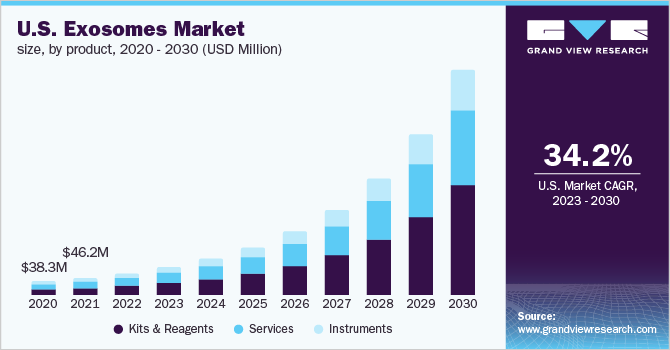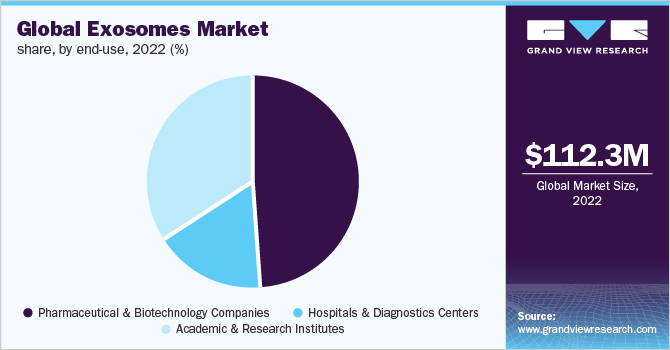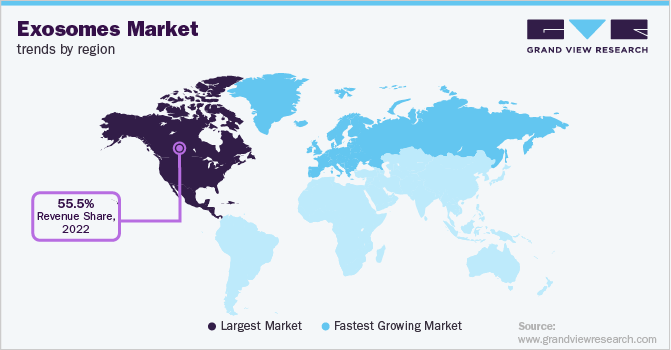- Home
- »
- Biotechnology
- »
-
Exosomes Market Size, Share & Growth Analysis Report, 2030GVR Report cover
![Exosomes Market Size, Share & Trends Report]()
Exosomes Market Size, Share & Trends Analysis Report By Product (Kits & Reagents, Services), By Application (Cancer, CVD), By Workflow (Isolation Methods, Downstream Analysis), By End-use, And Segment Forecasts, 2023 - 2030
- Report ID: GVR-2-68038-298-3
- Number of Report Pages: 150
- Format: PDF, Horizon Databook
- Historical Range: 2018 - 2021
- Forecast Period: 2023 - 2030
- Industry: Healthcare
Report Overview
The global exosomes market size was valued at USD 112.25 million in 2022 and is anticipated to expand at a compound annual growth rate (CAGR) of 32.75% by 2030. Exosomes are also known as Extracellular Vesicles (EVs) and are encased within a single outer membrane. They are secreted by all cell types and have been found in saliva, urine, plasma, semen, breast milk, Cerebral Spinal Fluid (CSF), amniotic fluid, bronchial fluid, bile, lymph, serum, gastric acid, synovial fluid, and tears. These vesicles carry proteins and genetic information throughout the body and create paths for communication between cells.

The key factors driving the industry include technological advancements in exosome isolation and analytical procedures, advanced applications of exosomes, growth in government and non-government initiatives for exosome research, and the increasing prevalence of cancer. The COVID-19 pandemic led to the disruption of clinical trials investigating the diagnostic and therapeutic potential of exosomes in 2020. In addition, nationwide lockdown restrictions, disruption of supply chains, and diversion of investments toward COVID-19-related products led to a decrease in the research and development activities involving exosomes.
Despite the adverse impact in 2020, the pandemic has opened up several new prospects for the development of COVID-19 vaccines and treatments with the use of exosomes, which, in turn, is expected to boost industry growth over the coming years. For instance, in August 2022, researchers at the North Carolina State University developed an inhalable COVID-19 vaccine based on exosomes. Exosomes can also be used to determine the onset or progress of multiple diseases, including infectious diseases, neurodegenerative diseases, cancer, and Cardiovascular Diseases (CVDs), among others.
Moreover, the advantages of exosomes in drug delivery, such as biological barrier permeability, low immunogenicity and toxicity, and stability in circulation are increasing the therapeutics applications in this domain. Thus, the potential applications of extracellular vesicles in diagnostics, therapeutics, and vaccine development are projected to drive the industry over the forecast period. The growing prevalence of cancer is leading to a high demand for effective novel therapeutic options for the diagnosis and treatment of the disease. For instance, according to the World Health Organization (WHO), in 2020, there were about 10 million cancer deaths, making it one of the foremost causes of death worldwide.
Moreover, in the U.S., according to the American Cancer Society, an estimated 1,918,030 new cancer cases and 609,360 cancer deaths were recorded by the end of 2022. Furthermore, technological advancements in exosome isolation and analytical procedures are anticipated to boost industry growth during the forecast years. For instance, in November 2022, Cell Guidance Systems introduced its Instant Exosomes and LipoQ assay products. The Instant Exosomes are freeze-dried exosomes and LipoQ is a lipid quantification assay for research applications. Such, developments are expected to boost the adoption of exosomes for research purposes and drive industry growth.
Product Insights
The kits and reagents product segment captured the highest share of 44.82% in 2022. Key players are launching innovative kits and reagents to broaden the applications of exosomes. For instance, in May 2022, Clara Biotech launched an ExoRelease starter kit for exosome isolation and purification. Such technological breakthrough products help researchers to investigate novel biomarkers to explore and refine exosome-based therapeutics and diagnostic applications. Hence, such developments are projected to drive segment growth in the years to come.
The services segment is anticipated to register a rapid growth rate during the forecast years. Isolation of exosomes can be a difficult, non-specific, and tedious process. Hence, end-users outsource the isolation, characterization, and therapeutic development to decrease the turn-around time. Several industry players are offering exosome services. For instance, AMSBIO, a U.S.-based company, offers services, such as exosome isolation & quantification, exosome miRNA isolation & sequencing, and exosome surface marker analysis and proteomics service. Thus, a broad range of offerings by various companies is expected to drive the segment.
Workflow Insights
The downstream analysis segment held the largest share of 58.46% in 2022. The downstream analysis includes detection, quantification, labeling, and modification or engineering of exosomes. These procedures may require sophisticated sample preparation, downstream data interpretation, and the use of analytical methods, such as RNA sequencing and mass spectrometry for proteomic analysis. Major players are offering various technologically advanced products for downstream analysis. For instance, System Biosciences, Exo-ELISA Ultra method quantifies exosomes in 4 hours by using micro samples. Hence, the increasing efficiency and utility of advanced downstream analysis techniques are contributing to segment growth. The isolation methods segment is projected to grow at a lucrative CAGR over the forecast period.
The optimal exosome isolation method is chosen based on the type and amount of starting material (e.g., urine, cell culture media, urine, plasma, etc.), intended therapeutic use, route of administration, availability of specialized equipment, as well as the desired end product. The common isolation methods include ultracentrifugation, immunocapture on beads, precipitation, and filtration, among others. Companies are offering smart isolation platforms for simpler workflow, faster turnaround time, high yield, and intact exosomes, which is fueling segment growth. For instance, System Biosciences offers the SmartSEC Platform, which is fast & easy to use and enables parallel processing of multiple samples.
Application Insights
The cancer segment held the largest market share of 31.88% in 2022. This can be attributed to the broad range of applications of exosomes in cancer diagnosis, prognosis, and treatment. Exosomes can be potentially used for the therapeutic delivery of RNAs, small molecules, and proteins to target cancer cells with high efficiency. In addition, lipids, proteins, and nucleic acids carried by exosomes are being studied as prospective targets for cancer treatment as well as promising biomarkers for cancer detection and prognosis. The rising cancer prevalence and increasing need for early detection of the disease are expected to boost the segment in the near future.
The infectious diseases segment is expected to expand at a rapid CAGR during the forecast period. Exosomes are known to be involved in the pathogenesis of numerous infectious diseases. The ability of extracellular vesicles to convey a variety of molecules to distant locations or over short distances, which enables the mediation of various biological functions, is a key characteristic of such vesicles. This delivery mechanism can be used for the development of therapeutic strategies, such as vaccination. All these factors are likely to aid revenue generation in this segment.
End-use Insights
The pharmaceutical & biotechnology companies segment captured the highest revenue share of 49.42% in 2022. The increasing demand for extracellular vesicle-based therapeutics and vaccines is driving the segment. Moreover, several pharmaceuticals & biotechnology companies are entering into partnerships & collaborations to improve large-scale production. For instance, in January 2023, Sartorius AG entered into a collaboration with RoosterBio to advance the downstream purification processes for the manufacturing of exosomes. Similarly, in November 2022, Sartorius BIA Separations and Exopharm entered into a partnership to improve large-scale therapeutic exosome production and commercialization.

Such initiatives are anticipated to drive the segment during the projected timeframe. The academic & research institutes segment is anticipated to grow at a significant CAGR over the forecast period. This is due to the increasing focus of several research institutes on the use of exosomes for the discovery and development of novel therapeutics. For instance, researchers at Carnegie Mellon University are working on understanding the biological activities of exosome-based cell communication to use exosome-based delivery of growth factors for applications in regenerative medicine. Such research activities are projected to boost segment growth in the near future.
Regional Insights
North America accounted for the highest share of 55.49% in 2022 and is projected to grow at the fastest rate over the forecast period. This is due to the rising government funding for the detection of new biomarkers and the increasing incidence of chronic conditions, such as cardiovascular diseases and cancer. In addition, growing research & development activities for the development of novel drugs, diagnostic methods, and treatment options are anticipated to drive the segment growth. Furthermore, the presence of major key players, such as Bio-Techne Corp., Hologic Inc., and Danaher Corp., in the region is likely to fuel the growth.

The Europe region is expected to grow at a rapid CAGR during the forecast period. The rising number of public and private collaborative initiatives in the region has resulted in continued market growth. For instance, the German Society for Extracellular Vesicles is a network of professionals involved in the field of exosomes. The society works for promoting collaborative research and supporting young academics in the field of exosomes in the region. Such initiatives are expected to foster long-term growth prospects for the market.
Key Companies & Market Share Insights
The global industry is growing at a rapid pace due to numerous strategic initiatives undertaken by key players involved. For instance, in October 2022, FUJIFILM Diosynth Biotechnologies entered into a strategic collaboration with RoosterBio to enable GMP-compliant manufacturing of exosome and cell therapies. Some of the key companies in the global exosomes market include:
-
Danaher Corp.
-
Hologic Inc.
-
Fujifilm Holdings Corp.
-
Lonza
-
Miltenyi Biotec
-
Bio-Techne Corp.
-
QIAGEN
-
Thermo Fisher Scientific, Inc.
-
Abcam plc
-
RoosterBio, Inc.
Exosomes Market Report Scope
Report Attribute
Details
Market size value in 2023
USD 141.3 million
Revenue forecast in 2030
USD 1.03 billion
Growth rate
CAGR of 32.75% from 2023 to 2030
Base year for estimation
2022
Historical data
2018 - 2021
Forecast period
2023 - 2030
Quantitative units
Revenue in USD million/billion and CAGR from 2023 to 2030
Report coverage
Revenue forecast, company ranking, competitive landscape, growth factors, and trends
Segments covered
Product, workflow, application, end-use, region
Regional scope
North America; Europe; Asia Pacific; Latin America; MEA
Country scope
U.S.; Canada; U.K.; Germany; France; Italy; Spain; Denmark; Sweden; Norway; Japan; China; India; South Korea; Australia; Thailand; Singapore; Brazil; Mexico; Argentina; South Africa; Saudi Arabia; UAE; Kuwait
Key companies profiled
Danaher Corporation; Hologic Inc.; Fujifilm Holdings Corporation; Lonza; Miltenyi Biotec; Bio-Techne Corporation; QIAGEN; Thermo Fisher Scientific, Inc.; Abcam plc; RoosterBio, Inc.
Customization scope
Free report customization (equivalent up to 8 analyst’s working days) with purchase. Addition or alteration to country, regional & segment scope.
Pricing and purchase options
Avail customized purchase options to meet your exact research needs. Explore purchase options
Global Exosomes Market Segmentation
This report forecasts revenue growth at the global, regional, and country levels and provides an analysis of the latest industry trends in each of the sub-segments from 2018 to 2030. For the purpose of this study, Grand View Research has segmented the global exosomes market report based on product, workflow, application, end-use, and region:
-
Product Outlook (Revenue, USD Million, 2018 - 2030)
-
Kits & Reagents
-
Instruments
-
Services
-
-
Workflow Outlook (Revenue, USD Million, 2018 - 2030)
-
Isolation Methods
-
Ultracentrifugation
-
Immunocapture on beads
-
Precipitation
-
Filtration
-
Others
-
-
Downstream Analysis
-
Cell surface marker analysis using flow cytometry
-
Protein analysis using blotting & ELISA
-
RNA analysis with NGS & PCR
-
Proteomic analysis using mass spectroscopy
-
Others
-
-
-
Application Outlook (Revenue, USD Million, 2018 - 2030)
-
Cancer
-
Neurodegenerative diseases
-
Cardiovascular diseases
-
Infectious diseases
-
Others
-
-
End-use Outlook (Revenue, USD Million, 2018 - 2030)
-
Pharmaceutical & biotechnology companies
-
Hospitals & diagnostics centers
-
Academic & research institutes
-
-
Regional Outlook (Revenue, USD Million, 2018 - 2030)
-
North America
-
U.S.
-
Canada
-
-
Europe
-
U.K.
-
Germany
-
France
-
Italy
-
Spain
-
Denmark
-
Sweden
-
Norway
-
-
Asia Pacific
-
Japan
-
China
-
India
-
Australia
-
Thailand
-
South Korea
-
Singapore
-
-
Latin America
-
Brazil
-
Mexico
-
Argentina
-
-
Middle East and Africa (MEA)
-
South Africa
-
Saudi Arabia
-
UAE
-
Kuwait
-
-
Frequently Asked Questions About This Report
b. North America dominated the exosomes market with a share of 55.49% in 2022. This is attributable to the presence of a substantial number of key players in the U.S. coupled with the well-established cell biology research domain in the region.
b. Some key players operating in the exosomes market include Danaher Corporation; Hologic Inc.; Fujifilm Holdings Corporation; Lonza; Miltenyi Biotec; Bio-Techne Corporation; QIAGEN; Thermo Fisher Scientific, Inc.; Abcam plc; and RoosterBio, Inc.
b. Key factors driving the market growth include innovations and new product development for exosome isolation and its analysis, rising cancer prevalence, and expanding clinical applications of exosomes.
b. The global exosomes market size was estimated at USD 112.25 million in 2022 and is expected to reach USD 141.3 million in 2023.
b. The global exosomes market is expected to grow at a compound annual growth rate (CAGR) of 32.75% from 2023 to 2030 to reach USD 1.03 billion by 2030.
Share this report with your colleague or friend.
![gvr icn]()
NEED A CUSTOM REPORT?
We can customize every report - free of charge - including purchasing stand-alone sections or country-level reports, as well as offer affordable discounts for start-ups & universities. Contact us now
![Certified Icon]()
We are GDPR and CCPA compliant! Your transaction & personal information is safe and secure. For more details, please read our privacy policy.
We are committed towards customer satisfaction, and quality service.
"The quality of research they have done for us has been excellent."





